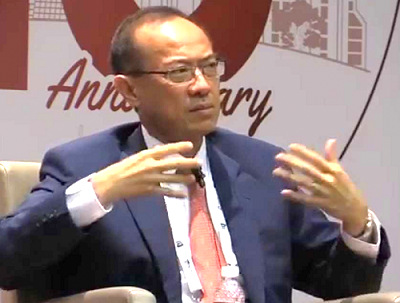The following article was recently posted by 'Singapore Matters' on its Facebook page, and is republished with permission.
THE SINGAPORE GOVERNMENT has accumulated vast reserves and Singaporeans think we are rich and some politicians have called for spending some of our reserves.
Presidential candidate (2011), Tan Jee Say, for example, once said that $60 billion was 'small change'. He said he was prepared to spend $10 billion to give away to any young Singaporean who wanted to start a business.
Here's what he said:"PMETs like yourselves, (if) you want to start a new industry, ask the government to give you one million dollars each and you do it for the next few years."
And his mathematics is really very simple. It goes like this:"With S$10 billion, divided by S$1m, then you could have how much ... 10,000 firms. 10,000 you multiply by three or five staff per company, (and for a) small company, you could have 50,000 jobs".
That easy huh? $1m and 'hey presto!' Jobs are created. What if the business fails? But of course it is not Mr Tan's money.
Singapore may have accumulated large reserves, but are we very rich?
Singapore's national reserves, or net assets (i.e. total assets minus liabilities of the Government and other entities specified in the Fifth Schedule under the Constitution), are a vital strategic resource for the country and strictly protected by the Constitution.
Specifically, the portion of reserves protected by the Constitution are the past reserves, that is, reserves accumulated by previous terms of governments. Any draw down on past reserves requires the President's approval.
|

“For as long as Singaporeans think that the government is rich, they will say look, c’mon, pass some over. But in fact, we have nothing. We are only a small island. We have no natural endowments. And what we have – I don’t know how many hundred billion dollars we have, even if you double it, what is that, compared to what others have, in the ground, in land, underwater?
"And in a crisis, if we have nothing, how do you sustain a diaspora? So yes, there must be a sense that the ordinary needs of a Singaporean has got to be looked after, and a proper balance between spending of the generation today and saving for the future generation."
- ex-Minister George Yeo, at the LKY School of Public Policy's 10th anniversary, Oct 2014.
|
As ex-Minister George Yeo said at the LKY School of Public Policy 10th year anniversary lecture, "But in fact, we have nothing. We are only a small island. We have no natural endowments. And what we have – I don’t know how many hundred billion dollars we have, even if you double it, what is that, compared to what others have, in the ground, in land, underwater? And in a crisis, if we have nothing, how do you sustain a diaspora?"
Many of us will remember the Asian Financial Crisis when currencies came under speculative attacks. The crisis hit Thailand first in 1997 and then spread to many other countries including Malaysia, Indonesia, the Philippines, S Korea, Hong Kong and China and subsequently to Russia and Brazil as well. For a timeline of the crisis, you can read it here.
Singapore's official foreign reserves (OFR) has helped to maintain confidence in the Singapore dollar in times of such crisis, and defend the currency against speculative attacks.
|
First time
Singapore dipped into a short recession during the Asian financial crisis. In 1999, then President Ong Teng Cheong said that he would approve the government's request to draw on past reserves to finance recession measures if asked. Fortunately there was no need to as then Prime Minister Goh Chok Tong said there was enough fund accumulated in the current reserves.
The global financial meltdown of 2008 shows how crucial financial reserves are to a small nation without natural resources like Singapore that is heavily dependent on international trade and finance.
The first time the government had to dip into the past reserves was during this crisis.
To shore up confidence in Singapore's financial institutions in the midst of a deepening credit crisis that was worldwide, the government announced in October 2008 that they would guarantee all bank deposits from October 2008 till the end of 2010.
The guarantee covered all Singapore dollar and foreign currency deposits of individuals and non-bank customers in banks, finance companies and merchant banks licensed by the Monetary Authority of Singapore (MAS). The government backed this guarantee with $150 billion from our financial reserves.
Without a strong reserves position, would the government have been able to do that? So our national reserves ARE a vital strategic resource for the country.
This move by the government was not an actual draw on the reserves. The funds would be used only if a depository financial institution failed. Fortunately that did not happen.
Then in January 2009, because of a fast deteriorating global economic environment and facing the prospect of a deep and prolonged recession, the government finally sought the President's approval to take out S$4.9 billion from past reserves to fund two one-off measures to boost the economy, namely, the Jobs Credit scheme and the Special Risk-Sharing Initiative (SRI).
The Jobs Credit scheme was designed to encourage employers to retain their workers by giving them a cash grant for every local employee on their payroll and the he bulk of the S$4.5 billion went into this. The remainder was for the SRI, which was aimed at encouraging banks to lend to companies by bearing a larger share of the risks. As a result unemployment did not rise very high.
By 2011, the Government had put back into the reserves the amounts drawn down to fund the extraordinary measures taken during the economic crisis.
|








